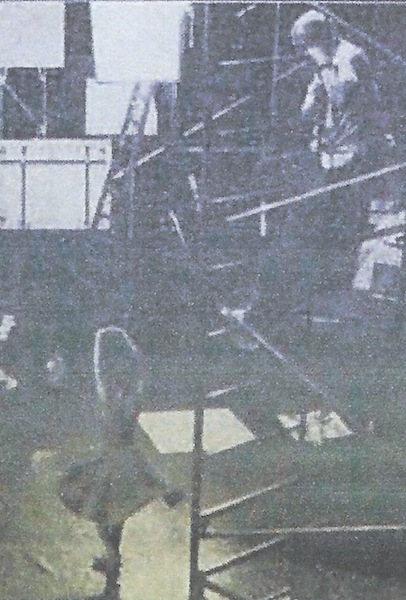Sunday, June 29, 1986.
THEIR APPROACHES ARE OUT of the ordinary. At both the Canada and Washington State pavilions, filmmakers invite Expo fairgoers to experience their messages.
B.C.'s nearest neighbour to the south, Washington has linked 69 slide and three 35mm movie projectors to present a seven-minute impression of the state. Called Northwest Passage, the show gives new meaning to the term "motion pictures."
To view the program, visitors step aboard a moving walkway — the "Trav-O-Lator" — that carries them past a 40-metre-long screen at the rate of five metres per minute. They have just enough time to see one full cycle of a continuous show composed of 15 30-second vignettes.
Produced by the New York-based Zacks and Perrier, Washington's presentation is an upbeat multi-image postcard promoting the state's tourist appeal. Paced like a snappy television commercial, it manages glimpses of sports, scenery and some culture (notably, Seattle's Maurice Sendak-designed Nutcracker ballet) along the way.
Applying multi-image technology to more serious matters is The Taming of the Demons, 20 minutes of philosophical razzle-dazzle featured in the Canada pavilion's 273-seat Teleglobe Theatre. Designed by Czech conceptual artist Emil Radok, this motion picture collage explores the nature and purpose of human communications.
The demons of the show's title are those forces that mankind does not understand, can not control, and therefore fears. These demons have been with us, says Radok, since the first humans trembled at the power and apparent caprice of nature.
To illustrate his thesis, the Montreal-based filmmaker uses nine variously-sized screens and a spinning globe that reflects a tenth image. As lightning bolts flash, twigs bend and a carousel turns, the picture is fragmented, repeated or shown from several points of view simultaneously.
According to Radok, man once tamed his demons by communicating — first through rituals and later, by means of science. In our own time, the demons have returned. Our creations threaten us, and fear is felt in the global village.
"To set things right,'' a narrator intones, "we must master these new tools." Descriptive rather than prescriptive, the Teleglobe-sponsored show attempts to make us aware of man's eternal dilemma.
Perhaps the most serious-minded of the Expo films, The Taming of the Demons is an example of pedagogical high art. Non-academics may find Radok's message and presentation a touch too ripe.
The above is a restored version of a Province review by Michael Walsh originally published in 1986. For additional information on this archived material, please visit my FAQ.
Afterword: Demons? What did Emil Radok know that we didn't? At the time of Expo 86, the director's patron, Teleglobe Canada, was a federal crown corporation. Founded in 1950 as the Canadian Overseas Telecommuncations Corportation, it was an international carrier tasked with handling overseas telephone and telex traffic from Canada to the world. As part of its public service mandate, it commissioned director Radok's multiscreen show to explain the scary wonders of modern communication in its 273-seat corner of the Canadian government's pavilion.
I've no idea why Teleglobe's executives chose Radok's cerebral take on modern tech to represent their enterprise. What I do know now is that the public corporation was living on borrowed time, having been targeted for privatization by the free-market government of then-Prime Minister Brian Mulroney. The axe fell in early 1987. Teleglobe was acquired by a small Montreal equipment manufacturer called Memotec Data Incorporated. Shortly thereafter, the business pages were covering an all-Canadian insider-trading scandal involving Memotic and Peter Blaikie, a former president of the PM's political party.
The allegations and investigations notwithstanding, the successful public utility was transferred to the private sector. After becoming Teleglobe Inc., the company was bought and sold a number of times in deals that generated millions of dollars in fees to bankers, lawyers and various consultants. Today (2016), it exists as Tata Communications (Canada) ULC, a Montreal-based unit of the multibillion-dollar Tata Group headquartered in Mumbai, India. As for Radok, one of many Czech film exiles that relocated to Canada after the events of 1968, he would see The Taming of the Demons win a Genie Award as the best Canadian film at Expo 86. He died in Montreal in 1994 at the age of 75.
See also: The nine articles included in this, the second of four Expo 86 special reports, explore the pavilions of:
|
14: Expo 86 British Columbia 15: Expo 86 Canada/Washington State 16: Expo 86 Canada 17: Expo 86 California 18: Expo 86 Mexico/Cuba/USA |
